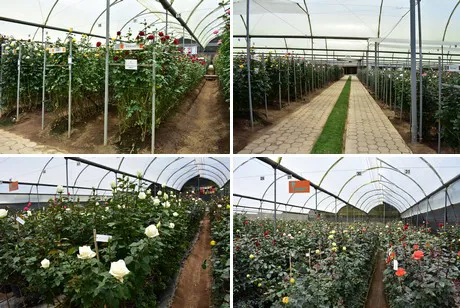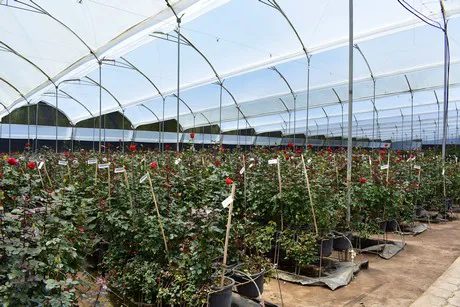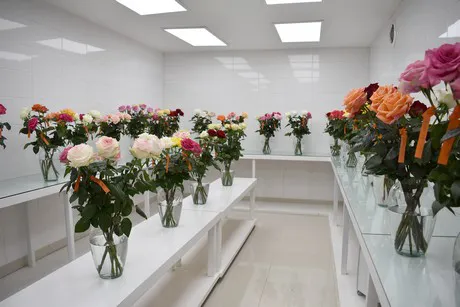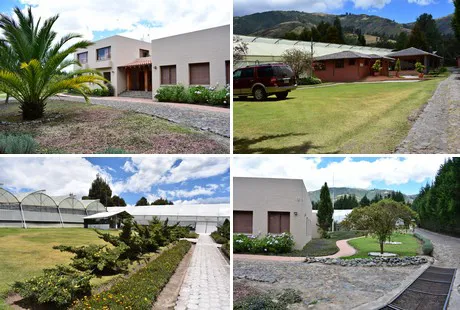Selecting and propagating rose varieties: It's a tough job, and Plantec Ecuador has been doing it for nearly three decades in Ecuador. They were the first to select rose varieties in Latin America, and over the years, they have grown to be the largest propagator of rose plants in Latin America. Nowadays, they represent five rose breeders and this allows them to offer a wide collection of varieties entering the market with new shapes and new colors every year. FloralDaily.com had the opportunity to visit this pioneering company and take a look at their 20 ha farm in San José de Oyambarillo, Yaruquí, where they propagate and select varieties.
Aviram Krell in the greenhouse holding an open "Explorer" rose.
Propagation
When propagating, it all starts with the clean material for the new varieties. The eyes from the varieties are grafted onto the rootstock in their propagation unit. This greenhouse is divided into different compartments where Plantec controls environmental factors such as light, humidity, CO2 and temperature. The recently grafted plants are placed in a sub-division of the greenhouse where high levels of humidity are maintained to protect the leaves from drying out.
 On the left: Humid atmosphere in the greenhouse while misting. On the right: A rootstock cutting in the greenhouse. .
On the left: Humid atmosphere in the greenhouse while misting. On the right: A rootstock cutting in the greenhouse. .
The rootstock plays a crucial part in the development cycle. The rootstock used is Natal briar, which is the most commonly used rose rootstock in the world. In addition to Natal Briar, for the past two years Plantec has been representing the Dutch company Plant Research Overberg and has introduced two new rootstocks: PRO 3 and PRO 5. "So far the data from the new rootstocks are overwhelmingly impressive for many varieties."
 On the left, the machine that makes and mixes the cocopeat substrate and on the right the substrate.
On the left, the machine that makes and mixes the cocopeat substrate and on the right the substrate.
Then, after grafting, the plants are grown in a coco peat substrate. The mixes are also made on site.
 Grafted plants in the greenhouse. On the right: first buds are showing.
Grafted plants in the greenhouse. On the right: first buds are showing.
From the graft to delivery of the plants takes approximately 7 weeks. During these weeks, the plants and particularly the roots are developing. To get the optimal plant, great care during this period is essential. "All the sections in the greenhouse are equipped with special techniques to create the best atmosphere for plant development, but manual care is still necessary. We pinch the plants when the first buds begin to develop. Our goal is to direct all the plant's energy towards building up its vegetative foundation. The more experienced personnel take the time to select the plants by size and prepare those plants for delivery." One of the most important aspects in the propagation in Plantec is the hardening sub-division. In this last part of the production of the plants Plantec makes certain that the plants become acclimatized to the conditions of the flower grower. "This is to ensure that the plants do not undergo any serious shock when planted in the rose grower's fields."
Selecting rose varieties
Another important task for Plantec is selecting the varieties from the five rose breeders they work with: German breeder Kordes Roses, Dutch breeder Interplant, French breeders George Delbard and Scea Rosaplants, and Australian breeder Grandiflora.
 Just before entering the selection greenhouses, one will enter the show area first.
Just before entering the selection greenhouses, one will enter the show area first.
So how does the selection work? Annually, Plantec receives more than 5,000 codes from their breeders and the checking begins. Aviram explains that they start from the consumer's point of view. "After planting, the first step is to check the flower: 'We ask ourselves, is it nice?' Then, we check how it behaves in the vase: 'What is the vase life and how does it develop in the vase?'" Only then do they start to look at the production behavior of the plants. "The first year, we try not to throw any varieties away. After the first year we began to discard during every selection cycle, which means around 85-90% of the varieties are discarded in their first selection cycle. In the second cycle we maintain around 7% of the remaining varieties."
 Codes and commercial varieties in the greenhouse
Codes and commercial varieties in the greenhouse
The work it entails
Selecting the varieties is a tough job, but in the past, not all growers realized the importance of this stage and the work it entails on a daily basis. The selection team in Plantec works around the clock every day to maintain accurate data on all of these varieties. Besides the vase life test which is oriented towards the final consumer, Plantec looks for the traits important to the grower. This includes data on: productivity, stem length, flower size, resistance to diseases, etc. The process of selecting a new variety starting at the initial reception of codes from the breeders until commercial delivery is between 4-6 years. Even after a variety is introduced to the commercial market, Plantec continues to collect data on how the variety behaves in the PRO rootstocks. "We are seeing that our new varieties are consistently showing positive results as we take more data collections of the new rootstocks", says Krell
 Red roses varieties in the greenhouse
Red roses varieties in the greenhouse
Red varieties - The search for the holy grail
Selecting red varieties is a challenge as they are usually grown under a special type of plastic and are therefore put all together in a greenhouse. So how to check them without getting all overwhelmed by the red? "What we do is we review them for about 1.5 hours and then go out of the greenhouse. This way every red gets a fair chance."
After the great success of Explorer, which in today's market is the most important red variety in Ecuador, this year Plantec was excited to introduced "FORTUNE". Sometimes one discovers a special variety accidentally, "Fortune really lived up to its name. We were very lucky when we began testing it, since under normal red plastic, its color lacked vibrancy, but when we decided to check the variety under normal plastic we saw the change in its color It is a very productive variety with a beautiful color, and an incredible vase life of over 20 days. Since this variety has no issue of burning or turning "blue" the plant benefits from normal plastic cover. "We here at Plantec believe that Fortune is going to be a fantastic compliment for the variety Explorer. During the fair in Ecuador, we consistently heard very positive reviews."
 The vase life room
The vase life room
Vase life tests
Throughout the year and throughout the trialing period of a variety, the flowers are tested in Plantec's vase life room, which has the same temperature as an average living room. "We find it important to have the flowers in a home setting to see the behavior of the flower." In the vase life room, codes and commercial varieties are trialed alongside. "Then, we can compare them with each other."
 At Plantec
At Plantec
Varieties with potential
Krell sees potential for more varieties and new trends. "We see a high potential for market trends to favor garden type varieties, Queen's Crown (Lavander garden type rose) and White O'Hara (white garden type rose) are fantastic examples. Traditional shapes will no doubt continue to be the biggest market in the rose world, and there, the variety Highlight, a pure white rose has all the potential to become a best seller.
Locations in Latin America
Next to San José de Oyambarillo, Yaruquí, Plantec also has a show room and experimental area at Flores Verdes in Cayambe.
For more information 
Plantec Ecuador
Aviram Krell
Email: public-relations@plantecuador.com
www.plantecuador.com
